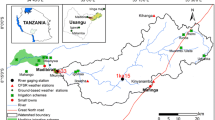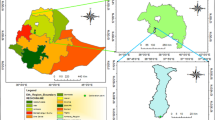Abstract
In any watershed, many factors influence land use/cover change (LUCC). The nonlinear relationships between these factors and LUCC are very complicated and make it difficult to build a model that is capable of accurately simulating the range of physical processes. The aim of this study was: (1) to simplify the structure of a simulation model and improve its simulation speed, and (2) evaluate the impact of land use/cover change on surface runoff and evapotranspiration. Firstly, a coupled cellular automata (CA) and artificial neural network (ANN) watershed land use/cover change simulation model, calibrated and validated using 1980 and 2000 land use data, respectively, was developed. It was used to simulate land use/cover type in the upper reaches of the Hanjiang Basin for 2020. Results indicate that the area of paddy field, dry land, shrubbery and construction land by 2020 will have increased; however, woodland, grassland and water areas will have decreased. Secondly, hydrological processes in the upper reaches of the Hanjiang Basin were simulated using the SWAT model. Finally, variations in watershed surface runoff and evapotranspiration for the LUCC 1980 and 2000 scenarios and the simulated 2020 scenario were analyzed. Results show that there is an increasing trend in the annual average runoff flowing into the Danjiangkou Reservoir, and that land use change has more influence on runoff throughout the year than during the flood season. The annual average evapotranspiration, annual runoff variation coefficient and annual runoff distribution coefficient were predicted to increase. Results confirm that (1) the ANN–CA model is capable of simulating land use/cover change for multiple classes, (2) the SWAT model facilitates sustainable land management planning, and (3) coupling the two models provides a new method for assessing the potential redistribution of land use types in the future.











Similar content being viewed by others
References
Arnold JG, Williams JR, Maidment DR (1995) Continuous-time water and sediment- routing model for large basins. J Hydrol Eng 121(2):171–183
Baker TJ, Miller SN (2013) Using the Soil and Water Assessment Tool (SWAT) to assess land use impact on water resources in an East African watershed. J Hydrol 486:100–111
Cao L, Zhang Y, Shi Y (2011) Climate change effect on hydrological processes over the Yangtze River basin. Quatern Int 244(2):202–210
Castillo CR (2013) Modeling impacts of land-use/land-cover change and variable precipitation on hydrology and water quality of a coastal watershed in Texas, vol 1. p 151053. Master’s Thesis, Texas A & M University. Available electronically from http://hdl.handle.net/1969
Chen X (2010) Land use change and its impact on water resources in East River Basin, South China. Watershed Manag 2010:978–989. doi:10.1061/41143(394)89
Chen YF, Zhang X (2012) Long-term variation trend and sustainability analysis of precipitation evaporation and runoff in Hanjiang Basin. Water Resour Power 30(6):6–9
Chen H, Guo SL, Xu CY, Singh VP (2007) Historical temporal trends of hydro-climatic variables and runoff response to climate variability and their relevance in water resource management in the Hanjiang basin. J Hydrol 344:171–184
Clarke KC (1997) A self-modifying cellular automaton model of historical urbanization in the San Francisco Bay area. Environ Plan B 24:247–261
Clarke KC, Gaydos LJ (1998) Loose-coupling a cellular automaton model and GIS: long-term urban growth prediction for San Francisco and Washington/Baltimore. Int J Geogr Inf Sci 12(7):699–714
Du JK, Rui HY, Zuo TH, Li Q, Zheng DP, Chen AL, Xu YP, Xu C-Y (2013) Hydrological simulation by SWAT model with fixed and varied parameterization approaches under land use change. Water Resour Manag 27(8):2823–2838
Eckhardt K, Breuer L, Frede HG (2003) Parameter uncertainty and the significance of simulated land use change effects. J Hydrol 273(1):164–176
Francos A, Elorza FJ, Bouraoui F, Bidoglio G, Galbiati L (2003) Sensitivity analysis of distributed environment simulation models: understanding the model behavior in hydrological studies at the catchment scale. Reliab Eng Syst Saf 79(2):205–218
Ghaffari G, Keesstra S, Ghodousi J, Ahmadi H (2010) SWAT—simulated hydrological impact of land-use change in the Zanjanrood basin, Northwest Iran. Hydrol Process 24(7):892–903
Githuia F, Thayalakumaranb T (2011) The effect of discretization of hydrologic response units on the performance of SWAT model in simulating flow and evapotranspiration//MSSANZ 2011 Perth
Guan Q, Wang L, Clarke KC (2005) An artificial-neural-network-based, constrained CA model for simulating urban growth. Cartogr Geogr Inf 32(4):369–380
Guo H, Hu Q, Jiang T (2008a) Annual and seasonal streamflow responses to climate and land-cover changes in the Poyang Lake basin, China. J Hydrol 355(1):106–122
Guo J, Guo SL, Chen H, Yan B, Zhang J (2008b) Prediction of the Danjiangkou Reservoir’s Runoff Trend. South-to-North Water Transf Water Sci Technol 6(4):78–82
Hargreaves GL, Hargreaves GH, Riley JP (1985) Agricultural benefits for Senegal River Basin. J Irrig Drain Eng 111(2):113–124
Herder C (2013) Impacts of land use changes on the hydrology of Wondo Genet catchment in Ethiopia. Dissertation, Hawassa University
Hilbert DW, Ostendorf B (2001) The utility of artificial neural networks for modeling the distribution of vegetation in past, present and future climates. Ecol Model 146:311–332
Li X, Yeh AG (2002) Neural-network-based cellular automata for realistic and idealized urban simulation. Acta Geogr Sin 2:005
Li X, Yeh AG (2005) Cellular automata for simulating complex land use systems using neural networks. Geogr Res 1:009
Li LJ, Jiang DJ, Li JY, Liang L, Zhang L (2007) Advances in hydrological response to land use/land cover change. J Nat Resour 22(2):211–224
Lu GB, Wang J, Wang HJ, Xia ZQ (2009) Impacts of human activities on the flow regime of the Hanjiang River. Res Environ Sci 15(1):12–13
Lu G, Wang J, Li Q et al (2012) Impacts of Danjiangkou reservoir on sediment regime of the Hanjiang River. Hydrol Res 43:64–72
Maetens W, Vanmaercke M, Poesen J, Jankauskas B, Jankauskiene G, Ionita I (2012) Effects of land use on annual runoff and soil loss in Europe and the Mediterranean A meta-analysis of plot data. Prog Phys Geogr 36(5):599–653
Mbonimpa EG, Yuan Y, Mehaffey MH, Jackson M (2012) SWAT model application to assess the impact of intensive corn-farming on runoff, sediments and phosphorous loss from an agricultural watershed in Wisconsin. J Water Resour Prot 4:423–431
Muleta MK, Nicklow JW (2005) Sensitivity and uncertainty analysis coupled with automatic calibration for a distributed watershed model. J Hydrol 306(1):127–145
Narsimlu B, Gosain AK, Chahar BR (2013) Assessment of future climate change impacts on water resources of Upper Sind River Basin, India using SWAT model. Water Resour Manag 27(10):3647–3662
Nash JE, Sutcliffe JV (1970) River flow forecasting through conceptual models part I—A discussion of principles. J Hydrol 10(3):282–290
Nunes AN, De Almeida AC, Coelho COA (2011) Impacts of land use and cover type on runoff and soil erosion in a marginal area of Portugal. Appl Geogr 31(2):687–699
Oeurng C, Sauvage S, Sánchez–Pérez JM (2011) Assessment of hydrology, sediment and particulate organic carbon yield in a large agricultural catchment using the SWAT model. J Hydrol 401(3):145–153
Penman HL (1956) Evaporation: an introductory survey. Neth J Agr Sci 4(1):9–29
Petchprayoon P, Blanken PD, Ekkawatpanit C (2010) Hydrological impacts of land use/land cover change in a large river basin in central-northern Thailand. Int J Climatol 30(13):1917–1930
Pijanowski BC, Brown DG, Shellito BA, Manik GA (2002) Using neural networks and GIS to forecast land use changes: a land transformation model. Comput Environ Urban Syst 26(6):553–575
Priestley CHB, Taylor RJ (1972) On the assessment of surface heat flux and evaporation using large-scale parameters. Mon Weather Rev 100(2):81–92
Rahul GK, Khurana M, Sinha AK (2013) Weather forecasting using soft computing: minimum temperature, maximum temperature & pressure. Weather 7(11):10–17
Setegn SG, Srinivasan R, Dargahi B (2008) Hydrological modelling in the Lake Tana Basin, Ethiopia using SWAT model. Open Hydrol J 2(2008):49–62
Setegn SG, Dargahi B, Srinivasan R, Melesse AM (2010) Modeling of sediment yield from Anjeni-Gauged watershed, Ethiopia using SWAT model. JAWRA J Am Water Resour Assoc 46(3):514–526
Shi PJ, Gong P, Li XB, Chen J, Qi Y, Pan YZ (2000) Methodology and practice of land use/land cover change. Science Press, Beijing
Song X, Duan Z, Kono Y, Wang M (2011) Integration of remotely sensed C factor into SWAT for modelling sediment yield. Hydrol Process 25(22):3387–3398
Sorooshian S, Duan Q, Gupta VK (1993) Calibration of rainfall-runoff models: application of global optimization to the Sacramento Soil Moisture Accounting Model. Water Resour Res 29(4):1185–1194
Tibebe D, Bewket W (2011) Surface runoff and soil erosion estimation using the SWAT model in the Keleta watershed, Ethiopia. Land Degrad Dev 22(6):551–564
Tong C, Jiang QH, Wu YQ, Cao Y (2002) Comparison on Water Ecology of Plant Community, Artificial Grassland and Shrub Forest Land in Zhungeer Hilly Region. J Soil Water Conserv 16(2):96–98
Van Griensven A, Bauwens W (2003) Multiobjective autocalibration for semidistributed water quality models. Water Resour Res 39(12):1348. doi:10.1029/2003WR002284
Vogl TP, Mangis JK, Rigler AK, Zink WT, Alkon DL (1988) Accelerating the convergence of the back-propagation method. Biol Cybern 59(4–5):257–263
Wang YJ, Jiang T, Xu CY, Shi YF (2006) Trend of evapotranspiration over the Yangtze River Basin in 1961–2000. Adv Clim Change Res 2(Suppl 1):35–40
Wolfram S (1983) Statistical mechanics of cellular automata. Rev Mod Phys 55(3):601
Wolfram S (1984) Cellular automata as models of complexity. Nature 311:419–424
Wolfram S (1986) Theory and applications of cellular automata. World Scientific, Singapore
Wu F, Webster CJ (1998) Simulation of land development through the integration of cellular automata and multicriteria evaluation. Environ Plan B 25:103–126
Xu ZX, Pang JP, Liu CM et al (2009) Assessment of runoff and sediment yield in the Miyun Reservoir catchment by using SWAT model. Hydrol Process 23(25):3619–3630
Xu RL, Chen H, Guo J (2010) Impact of climate change on hydrological extreme events in the upper reaches of the Hanjiang River Basin. J Beijing Norm Univ (Nat Sci) 46(3):383–386
Yeh AG, Li X (2004) Integration of neural networks and cellular automata for urban planning. Geo-spatial Inf Sci 7(1):6–13
Yuan F, Ren L, Yu Z, Zhu Y, Xu J, Fang X (2012) Potential natural vegetation dynamics driven by future long-term climate change and its hydrological impacts in the Hanjiang River Basin, China. Hydrol Res 43(1–2):73–90
Zamyatin A, Markov N (2005) Approach to land cover change modelling using cellular automata. In: Proceedings of 8th Conference on Geographic Information Science, Estoril, Portugal, AGILE. pp 587–592
Zhang X, Xia J (2009) Coupling the hydrological and ecological process to implement the sustainable water resources management in Hanjiang River Basin. Sci China Ser E Technol Sci 52(11):3240–3248
Zhang Z, Zhao X (2005) Environment assessment and prediction for the Danjiangkou Reservoir area of the Middle Route of Chinese South to North Water Transfer Project. J Xiangfan Univ 26(5):76–79
Zhang X, Srinivasan R, Hao E (2007) Predicting hydrologic response to climate change in the Luohe River basin using the SWAT model. Transact ASABE 50(3):901–910
Zhang Q, Xu Z, Shen Z, Li S, Wang S (2009) The Han River watershed management initiative for the South-to-North Water Transfer Project (Middle Route) of China. Environ Monit Assess 148(1–4):369–377
Zhang A, Zhang C, Fu G, Wang B, Bao Z, Zheng H (2012) Assessments of impacts of climate change and human activities on runoff with SWAT for the Huifa River Basin, Northeast China. Water Resour Manag 26(8):2199–2217
Acknowledgments
The work was supported by the Natural Science Foundation of China (No. 51279143 and No.71073115).
Author information
Authors and Affiliations
Corresponding author
Rights and permissions
About this article
Cite this article
Deng, Z., Zhang, X., Li, D. et al. Simulation of land use/land cover change and its effects on the hydrological characteristics of the upper reaches of the Hanjiang Basin. Environ Earth Sci 73, 1119–1132 (2015). https://doi.org/10.1007/s12665-014-3465-5
Received:
Accepted:
Published:
Issue Date:
DOI: https://doi.org/10.1007/s12665-014-3465-5




